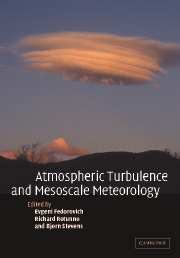Book contents
- Frontmatter
- Contents
- Preface
- Douglas K. Lilly: a biography
- Part I Atmospheric turbulence
- Part II Mesoscale meteorology
- 6 Model numerics for convective-storm simulation
- 7 Numerical prediction of thunderstorms: fourteen years later
- 8 Tropical cyclone energetics and structure
- 9 Mountain meteorology and regional climates
- 10 Dynamic processes contributing to the mesoscale spectrum of atmospheric motions
- Appendix A Douglas K. Lilly: positions, awards, and students
- Appendix B List of publications by Douglas K. Lilly
- Index
- Plate section
6 - Model numerics for convective-storm simulation
Published online by Cambridge University Press: 04 August 2010
- Frontmatter
- Contents
- Preface
- Douglas K. Lilly: a biography
- Part I Atmospheric turbulence
- Part II Mesoscale meteorology
- 6 Model numerics for convective-storm simulation
- 7 Numerical prediction of thunderstorms: fourteen years later
- 8 Tropical cyclone energetics and structure
- 9 Mountain meteorology and regional climates
- 10 Dynamic processes contributing to the mesoscale spectrum of atmospheric motions
- Appendix A Douglas K. Lilly: positions, awards, and students
- Appendix B List of publications by Douglas K. Lilly
- Index
- Plate section
Summary
Introduction
Over the past forty years, the numerical simulation of atmospheric convection has evolved from its infancy in two-dimensional dry thermals to highly sophisticated three-dimensional models used for numerical weather prediction (NWP) at convective scales. This advancement has been feasible because of the enormous growth in computing power, increasing from thousands to billions of calculations per second during this period (Wilhelmson and Wicker, 2001). However, significant advancements in model numerics, physical parameterizations, and data analysis have also been required to capture the complexity of atmospheric convection and convective storms in numerical simulation models. Throughout these decades, Doug Lilly has been a major force in advancing this technology, both in his own research and in motivating the achievements of others.
Lilly (1962) conducted pioneering research on the numerical simulation of buoyant thermals that laid the groundwork for the 3D convective storm models that evolved in subsequent decades. Thiswork included a newapproach for grid staggering (Lilly, 1961) and improved techniques for the treatment of subgrid turbulence in an inertial subrange using a nonlinear eddy viscosity proportional to the local shear and modified by buoyancy effects through a Richardson-number dependency. Lilly solved the full 2D compressible equations in flux form, placing strong emphasis on both numerical stability and accurate conservation (analyzed systematically for alternative numerical schemes in Lilly, 1965). Lilly fostered the development of one of the early 3D cloud models, the Klempeacute;Wilhelmson model, and in founding and directing the Center for Analysis and Prediction of Storms (CAPS), he promoted development of the Atmospheric Research and Prediction System (ARPS).
- Type
- Chapter
- Information
- Atmospheric Turbulence and Mesoscale MeteorologyScientific Research Inspired by Doug Lilly, pp. 117 - 138Publisher: Cambridge University PressPrint publication year: 2004
- 4
- Cited by

